When it comes to cooking cabbage, the possibilities are endless. From sautéing to boiling, cabbage can be prepared in various ways to create mouthwatering dishes that will satisfy your taste buds. Whether you’re a cabbage aficionado or just starting to explore this versatile vegetable, this article will provide you with tips, recipes, and serving suggestions to help you cook perfect cabbage dishes every time.
Key Takeaways:
- There are at least 14 types of cabbage to choose from, offering a range of flavors and textures.
- Cabbage can be sautéed or boiled to create delicious and healthy side dishes.
- Include cabbage in your meals to benefit from its nutritional value, such as vitamins C and K, potassium, and fiber.
- When cooking cabbage, choose firm and heavy heads, and season with salt and pepper to enhance the flavors.
- Pair cabbage dishes with various proteins and get creative with flavor combinations to create exciting meals.
Different Ways to Cook Cabbage
When it comes to cooking cabbage, there are various methods you can try to create delicious and satisfying dishes. Whether you’re looking for a quick and easy option or a more flavorful approach, cabbage can be transformed into a versatile ingredient. Let’s explore two popular cooking methods: sautéing and boiling.
Sautéed Cabbage
If you want to enhance the natural flavors of cabbage and add a touch of caramelization, sautéing is the way to go. This method brings out the sweetness of cabbage while preserving its crisp texture. To make sautéed cabbage, you’ll need:
- 1 head of cabbage, thinly sliced
- 2 tablespoons of olive oil
- 2 tablespoons of butter
- Salt and pepper to taste
- 1 tablespoon of apple cider vinegar (the surprise ingredient!)
Heat the olive oil and butter in a large skillet over medium heat. Add the sliced cabbage and sauté for about 8-10 minutes, or until it becomes tender and slightly golden. Season with salt and pepper, then drizzle the apple cider vinegar over the cabbage and toss gently to combine. Serve as a flavorful side dish alongside your favorite proteins and enjoy!
Boiled Cabbage
For a simple and comforting cabbage dish, boiling is a classic cooking method. Boiled cabbage is tender, slightly sweet, and pairs well with many other flavors. Here’s what you’ll need:
- 1 head of cabbage, cut into wedges
- 2 tablespoons of butter
- Salt and pepper to taste
Bring a large pot of salted water to a boil. Add the cabbage wedges and cook for about 5-7 minutes, or until they become tender. Drain the cabbage and return it to the pot. Add the butter, salt, and pepper, then gently toss until the cabbage is coated. The result is a delicious side dish that can complement a range of proteins and vegetables.
Whether you choose to sauté or boil cabbage, these methods offer different taste profiles and textures, allowing you to experiment and find your favorite way to enjoy this versatile vegetable.
Try the sautéed cabbage recipe for a more intense and flavorful experience, or opt for the simple and comforting boiled cabbage dish. Whichever method you choose, cooking cabbage opens up a world of culinary possibilities.
| Sautéed Cabbage | Boiled Cabbage |
|---|---|
| Method | Method |
| Caramelizes and enhances the flavor of cabbage | Creates tender and slightly sweet cabbage |
| Requires olive oil, butter, salt, pepper, and apple cider vinegar | Requires cabbage, butter, salt, and pepper |
| Great as a side dish for various proteins and vegetables | Pairs well with a range of proteins and other dishes |
A Flavorful Recipe: Sautéed Cabbage
If you’re looking for a quick and easy cabbage recipe that’s bursting with flavor, this sautéed cabbage dish is perfect for you. With just a handful of ingredients and minimal prep time, you can whip up a delicious and healthy side dish that will impress your family or guests.
For this recipe, you’ll need:
- 1 medium green cabbage
- 2 tablespoons olive oil
- 2 tablespoons butter
- Salt and pepper to taste
- 1 tablespoon apple cider vinegar
To start, thinly slice the cabbage. Heat the olive oil and butter in a large skillet over medium heat. Once the butter has melted and the skillet is hot, add the cabbage slices and season with salt and pepper. Stir-fry the cabbage for about 5-7 minutes, or until it becomes tender and golden brown.
“Sautéed cabbage is a simple yet flavorful dish that pairs well with a variety of proteins. The combination of butter, olive oil, and apple cider vinegar adds a tangy and bright flavor to the cabbage. Plus, the caramelization from sautéing brings out the sweetness of the cabbage, making it absolutely delicious.”
After sautéing the cabbage, remove the skillet from heat and drizzle the apple cider vinegar over the cabbage. Give it a quick toss to evenly distribute the flavors. The apple cider vinegar not only adds a tangy taste but also brings a refreshing acidity to balance the richness of the dish.
Tips and Variations
If you want to make this sautéed cabbage dish your own, here are a few tips and variations you can try:
- Add some chopped garlic or onions to the skillet for extra aromatics and flavor.
- Sprinkle some red pepper flakes for a spicy kick.
- Replace the apple cider vinegar with balsamic vinegar for a different twist.
- Add cooked bacon or pancetta to make it a heartier side dish.
Now, let’s take a look at the nutritional profile of sautéed cabbage:
| Nutrient | Amount per Serving |
|---|---|
| Calories | 140 |
| Protein | 3g |
| Fat | 10g |
| Carbohydrates | 10g |
| Fiber | 4g |
| Vitamin C | 85% of the Daily Value (DV) |
| Vitamin K | 100% of the DV |
This sautéed cabbage recipe is not only delicious but also packed with essential nutrients. Cabbage is rich in vitamins C and K, and it’s also a good source of fiber. It’s a great option for those looking to incorporate healthy and nutritious meals into their diet.
Now that you have a flavorful sautéed cabbage recipe in your repertoire, you can enjoy it as a side dish with your favorite proteins or use it as a base for a more elaborate meal. Get creative in the kitchen and explore the endless possibilities of cooking cabbage!
Boiled Cabbage: A Simple and Tasty Recipe
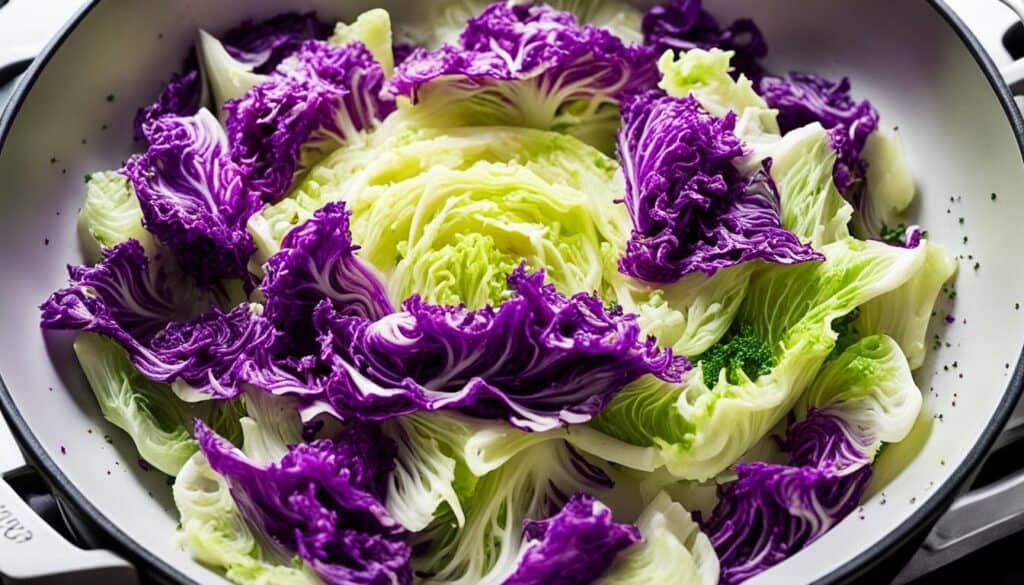
If you’re looking for a simple and delicious way to enjoy cabbage, boiled cabbage is the perfect choice. This traditional cooking method results in tender and sweet cabbage that can be used as a versatile side dish to complement a variety of proteins. Let me guide you through the steps to create this easy cabbage recipe.
To start, you’ll need:
- 1 head of cabbage
- Water
- Salt
- Butter
- Pepper
Step 1: Trim the outer leaves and excess stem from the cabbage.
Step 2: Cut the cabbage in half, then into wedges.
Step 3: In a large skillet or Dutch oven, add enough water to cover the cabbage wedges.
Step 4: Sprinkle salt into the water to enhance the flavor.
Step 5: Place the cabbage wedges into the skillet or Dutch oven and bring the water to a simmer.
Step 6: Let the cabbage simmer for about 5-7 minutes or until it softens.
Step 7: Once the cabbage is tender, drain the water and return the pan to low heat.
Step 8: Allow any remaining moisture to evaporate for a few minutes.
Step 9: Finish the dish by adding melted butter, salt, and pepper to taste.
Boiled cabbage pairs well with a variety of proteins, such as roasted chicken, grilled steak, or even vegetarian options like tofu or tempeh. Its sweet and tender nature is also a delicious addition to hearty soups or stews.
Please note that boiling cabbage may cause a strong odor. However, by not overcooking the cabbage and following these steps, you can minimize any unwanted smells.
Now, let’s take a look at a table summarizing the recipe:
| Ingredients | Instructions |
|---|---|
| 1 head of cabbage | Trim the outer leaves and excess stem. |
| Water | Add enough water to a skillet or Dutch oven to cover the cabbage wedges. |
| Salt | Sprinkle salt into the water to enhance the flavor. |
| Butter | Add melted butter to taste. |
| Pepper | Add pepper to taste. |
Why Choose Boiled Cabbage?
“Boiled cabbage is an easy and versatile side dish that brings out the natural sweetness of this nutritious vegetable.”
Boiling cabbage is a straightforward cooking method that preserves the cabbage’s natural flavors and nutrients. It softens the leaves while maintaining their vibrant green color. The simplicity of this recipe allows the cabbage to shine, making it a popular choice for those who prefer a more subtle taste.
Now that you know how to prepare boiled cabbage, you can confidently whip up this tasty side dish for your next meal. The tender and sweet cabbage pairs well with a variety of main courses and provides a nutritious addition to any menu. Enjoy the satisfying flavors of this easy cabbage recipe!
Health Benefits of Cabbage
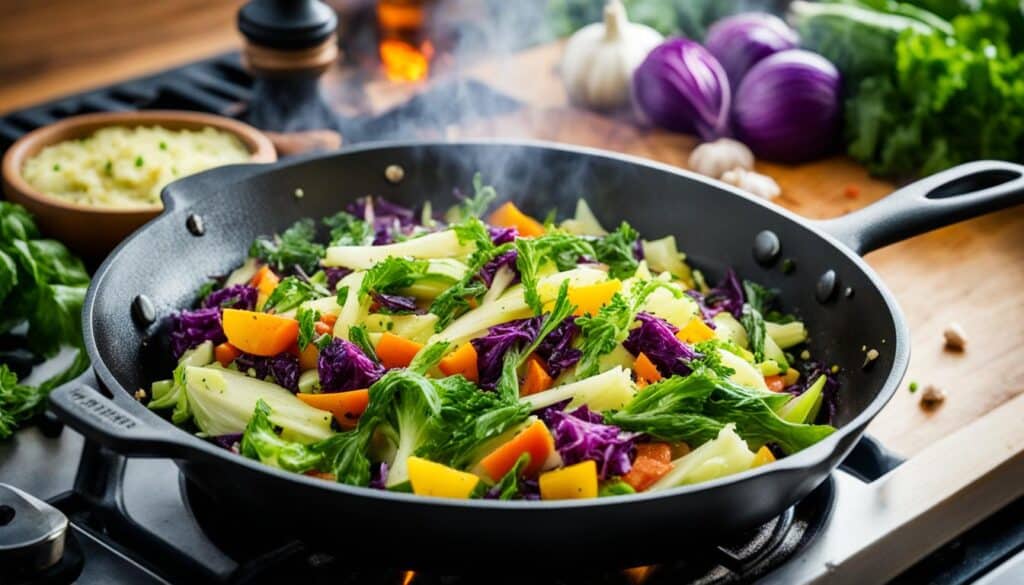
Cabbage is not only delicious but also packed with nutritional benefits. Including cabbage in your meals can contribute to a well-rounded and nutritious diet. Here are some of the health benefits of cabbage:
Vitamins and Minerals
- Vitamin C: Cabbage is a good source of vitamin C, which is essential for immune function and collagen production.
- Vitamin K: Cabbage contains vitamin K, which is important for blood clotting and bone health.
- Potassium: Cabbage is a great source of potassium, which helps regulate blood pressure and fluid balance.
- Magnesium: Cabbage provides magnesium, which is involved in many biochemical reactions in the body.
Phytonutrients
Cabbage is rich in phytonutrients, which are plant compounds with various health benefits. These compounds act as antioxidants and have anti-inflammatory properties, which may help reduce the risk of chronic diseases.
Low in Calories and Fat, High in Fiber
Cabbage is a low-calorie and low-fat vegetable, making it an excellent choice for weight management. It is also high in fiber, which aids in digestion and promotes a healthy gut.
With its nutritional profile, cabbage is a great addition to your cooking repertoire. Whether you’re sautéing it, boiling it, or incorporating it into salads, you can enjoy the health benefits of cabbage while savoring its delicious taste.
| Type of Cabbage | Vitamin C (mg) | Vitamin K (mcg) | Potassium (mg) | Magnesium (mg) |
|---|---|---|---|---|
| Green Cabbage | 36 | 53 | 217 | 15 |
| Red Cabbage | 51 | 34 | 243 | 20 |
| Savoy Cabbage | 28 | 43 | 204 | 14 |
Tips for Cooking Perfect Cabbage Dishes
To ensure your cabbage dishes turn out perfect every time, consider these helpful tips:
Selecting the Right Cabbage
When selecting cabbage, choose heads that feel firm and heavy. Avoid wilted or damaged leaves. Opt for fresh and vibrant cabbage to ensure the best flavor and texture in your dishes.
Preparation Techniques
For sautéing or boiling cabbage, cut it into thin slices or wedges to ensure even cooking. Thinner slices or wedges cook more quickly and evenly, resulting in tender and delicious cabbage. This also allows for better absorption of flavors from seasonings and other ingredients.
Seasoning Suggestions
Season your cabbage dishes well with salt and pepper to enhance the flavors. These staple seasonings provide a simple yet effective way to bring out the natural sweetness of cabbage. Additionally, don’t be afraid to experiment with different seasonings, such as vinegar or hot sauce, to add extra depth and zing to your dishes.
Perfect Cooking Time
Avoid overcooking cabbage, as it can result in strong odors and a mushy texture. Cooking cabbage just until tender helps to retain its crispness and nutritional value while ensuring a pleasant texture in your dishes. Pay attention to the recommended cooking times in recipes and adjust slightly based on personal preference.
Follow these tips and unlock the full potential of cabbage in your cooking. With these suggestions in mind, you’ll be able to create delicious and healthy cabbage dishes that are sure to impress.
Serving Suggestions for Cabbage Dishes
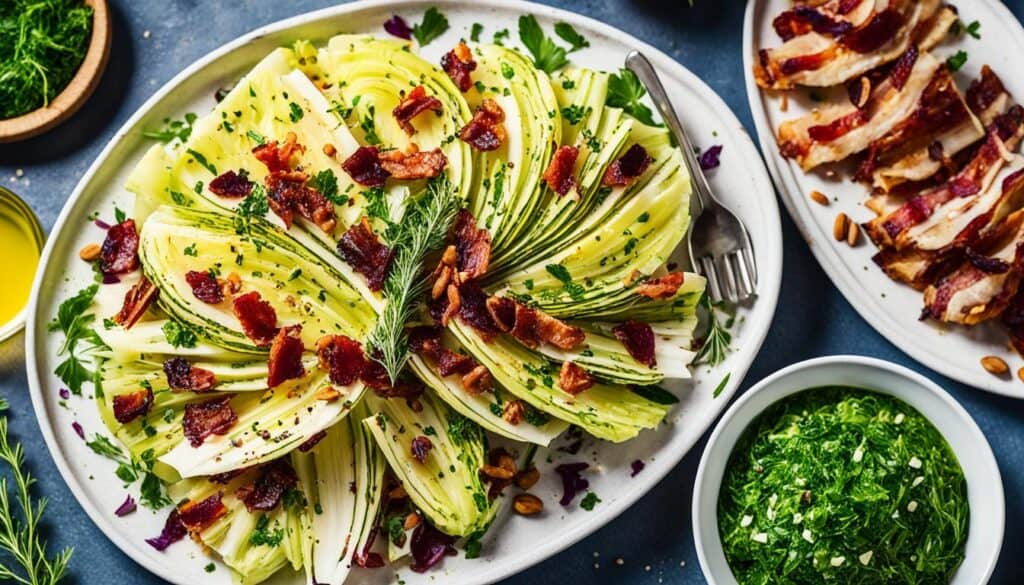
Cabbage dishes can be versatile and complement a variety of main courses. When it comes to serving cabbage, there are countless delicious possibilities. Here are some mouth-watering ideas to inspire your next cabbage creation:
1. Sautéed Cabbage with Pork Chops
Pair tender sautéed cabbage with perfectly cooked pork chops for a satisfying and flavorful meal. The crispy edges of the cabbage complement the juicy pork chops, creating a delightful combination of textures and tastes.
2. Grilled Cauliflower Steaks with Cabbage
For a meatless Monday option, try serving sautéed cabbage alongside grilled cauliflower steaks. The caramelized cauliflower adds a smoky flavor that pairs wonderfully with the slightly sweet and tangy cabbage.
3. Boiled Cabbage with Ham
Add some comfort to your plate by enjoying boiled cabbage with deliciously salty ham. The tender cabbage absorbs the savory flavors of the ham, creating a satisfying and hearty combination that is perfect for a cozy family dinner.
4. Cabbage Dish with Roast Chicken
Roast chicken is a classic main course, and it pairs beautifully with cabbage dishes. Whether you choose sautéed or boiled cabbage, the tender and flavorful meat of the roasted chicken complements the cabbage’s natural sweetness.
5. Hearty Sandwiches with Cabbage
For a complete and satisfying meal, serve your cabbage dish with a hearty sandwich. From a juicy steak burger to a flavorful turkey burger, the combination of the cabbage’s crunch and the sandwich’s protein-packed fillings makes for a delightful and filling meal.
Get creative and experiment with different flavor combinations to find your favorite cabbage meal ideas. Whether you prefer a meaty accompaniment or a plant-based option, cabbage is a versatile ingredient that can elevate any dish with its unique texture and taste.
Storing and Reheating Cabbage Dishes
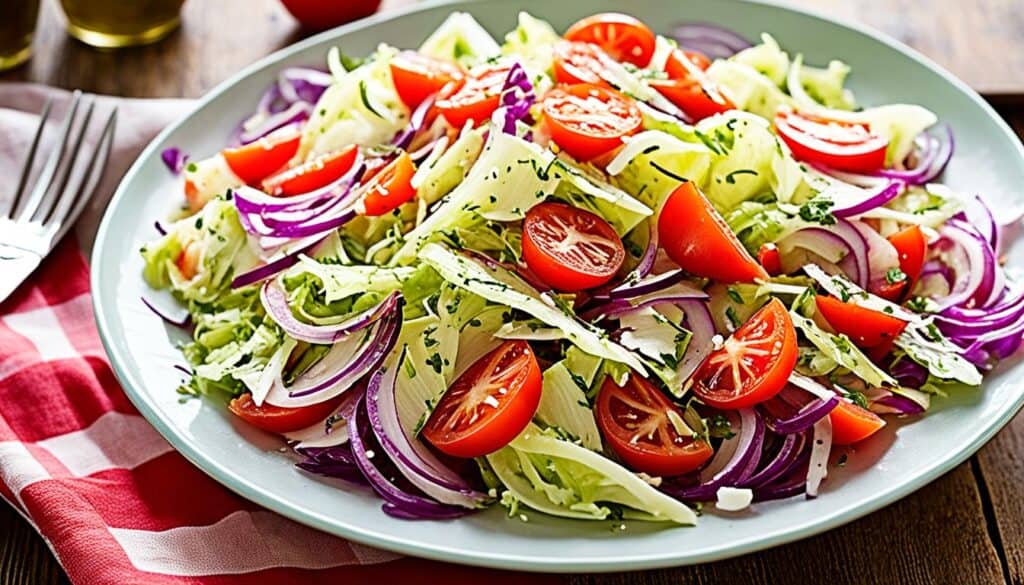
If you have leftovers from your cabbage dishes, proper storage is key to maintain their flavor and freshness. To keep your cabbage dishes delicious for later consumption, follow these simple steps:
Refrigerating Leftover Cabbage Dishes
- Place the leftover cabbage in an airtight container to prevent any odors from spreading to other foods in the fridge.
- Label the container with the dish name and the date it was stored to help you keep track of its freshness.
- Store the container in the refrigerator. Cabbage dishes can typically last up to one week when refrigerated at the proper temperature (below 40°F or 4°C).
Remember, if the cabbage has been previously reheated, it is best to refrigerate it within two hours of being served to minimize the risk of bacteria growth.
Reheating Cabbage Dishes
When it’s time to enjoy your leftover cabbage dishes, follow these steps to reheat them properly:
- Transfer the cabbage from the refrigerator to a microwave-safe bowl or plate.
- Gently warm the cabbage in the microwave at medium power, stirring occasionally, until it reaches your desired temperature.
- For additional flavor, add a sprinkle of salt and a splash of apple cider vinegar to enhance the taste.
With these simple steps, your reheated cabbage dishes will be just as delicious as when they were first prepared.
Freezing Cabbage Dishes
If you have larger quantities of cabbage dishes or want to store them for an extended period, freezing is a great option. Here’s how to freeze cabbage dishes:
- Place the cabbage dish in a freezer-safe container, ensuring it is tightly sealed to prevent freezer burn.
- Label the container with the dish name and the date it was frozen.
- Store the container in the freezer, ideally at 0°F (-18°C) or below.
Note that while frozen cabbage dishes may experience slight texture changes upon thawing, the taste will still be delicious.
Storage and Reheating Guidelines
| Storage Method | Duration | Reheating Method |
|---|---|---|
| Refrigeration | Up to one week | Microwave |
| Freezing | 2-3 months | Microwave |
By following these storage and reheating guidelines, you can make the most of your cabbage dishes, even days after they are initially prepared. With a quick warm-up and a sprinkle of seasoning, your leftovers will taste just as fresh and flavorful. Embrace the convenience and enjoy the deliciousness!
Conclusion
Cooking cabbage is a delightful culinary experience that opens up a world of flavorful possibilities. Whether you prefer sautéing or boiling, there are numerous ways to prepare cabbage and create delicious dishes. From quick weeknight sides to healthy meal options, cabbage is a versatile vegetable that can be easily incorporated into your cooking repertoire.
Not only does cabbage taste great, but it also offers a range of nutritional benefits. Packed with vitamins C and K, as well as potassium and fiber, cabbage is a healthy addition to any diet. Its low calorie and fat content make it an ideal choice for those looking to maintain a balanced and nutritious lifestyle.
So why not get creative in the kitchen and explore the world of cabbage recipes? Try out different cooking methods, experiment with seasonings, and discover the delightful flavors that cabbage can bring to your table. With its versatility and health benefits, cabbage is sure to become a staple ingredient in your kitchen.
So next time you’re at the grocery store, grab a head of cabbage and embark on a culinary adventure. Whether you’re whipping up a quick sautéed cabbage dish or preparing a hearty boiled cabbage meal, you’re sure to enjoy the delicious and nutritious results.

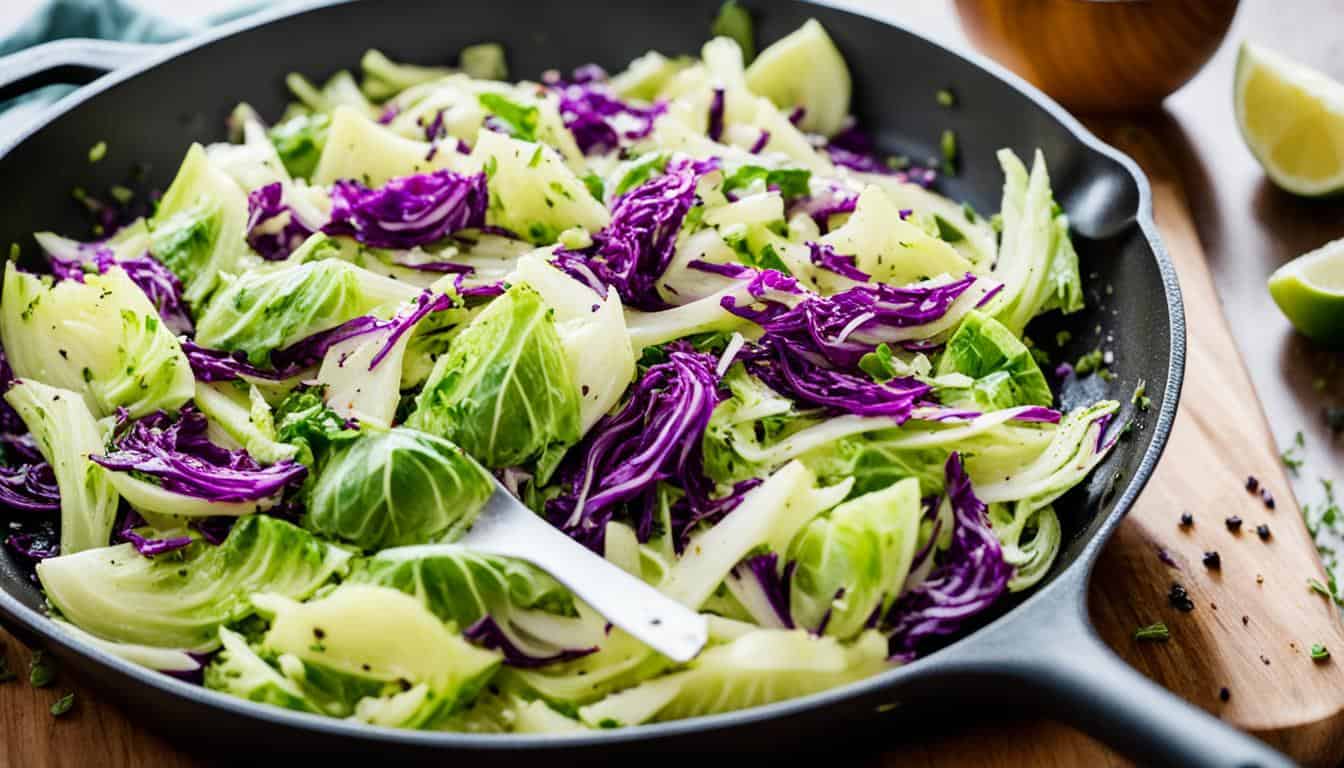



Leave a Reply